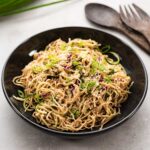Embark on a culinary journey that harmoniously blends the vibrant flavors of the Mediterranean with the health-boosting principles of the ketogenic diet. Low-Carb Mediterranean Keto Meals offers a unique approach to weight management and improved well-being, combining the richness of olive oil, fresh vegetables, and lean proteins with the fat-focused macronutrient ratio of keto. This isn’t just about restriction; it’s about discovering a world of delicious and satisfying meals that support your health goals.
This guide provides a comprehensive exploration of this exciting dietary approach, detailing the principles, offering sample meal plans, showcasing delectable recipes, and addressing potential challenges. We’ll delve into the macronutrient balance, permitted and restricted foods, and provide practical strategies to ensure a smooth and successful transition to this lifestyle. Prepare to savor the Mediterranean sunshine while achieving your keto goals!
Understanding the Low-Carb Mediterranean Keto Diet
The Low-Carb Mediterranean Keto diet cleverly blends the heart-healthy principles of the Mediterranean diet with the fat-burning power of the ketogenic approach. It’s a dietary strategy that emphasizes healthy fats while significantly restricting carbohydrate intake, resulting in a metabolic state called ketosis. This approach aims to harness the benefits of both diets, offering a potentially powerful tool for weight management and improved metabolic health. The result is a vibrant and flavorful eating plan that prioritizes nutrient-dense foods.
Macronutrient Ratios
The cornerstone of this diet lies in its specific macronutrient distribution. Unlike standard keto diets which can sometimes feel restrictive, this approach incorporates a wider variety of foods while still maintaining the ketosis-inducing ratio. A typical macronutrient breakdown for a Low-Carb Mediterranean Keto diet would be approximately 70-80% healthy fats, 15-20% protein, and 5-10% carbohydrates. This precise balance is crucial for triggering and sustaining ketosis, the metabolic state where your body primarily burns fat for fuel instead of glucose. The ratio may need to be adjusted based on individual needs and responses, with careful monitoring through blood ketone levels or urine ketone strips. For example, an individual with higher activity levels might need a slightly higher protein intake to support muscle mass.
Permitted and Restricted Food Groups
Understanding which foods are permitted and restricted is essential for successful adherence to this dietary approach. The emphasis is on whole, unprocessed foods.
Permitted Foods
A vibrant array of foods is permissible, painting a picture of a colorful and flavorful plate. Think luscious avocados brimming with healthy fats, their creamy texture a delightful contrast to the peppery bite of Kalamata olives. Imagine the rich aroma of extra virgin olive oil drizzled over grilled salmon, its flesh flaky and moist, complemented by the bright acidity of lemon wedges. The diet also embraces an abundance of leafy greens – vibrant spinach, crisp romaine lettuce, and earthy kale – providing essential vitamins and minerals. Other permitted foods include nuts (almonds, walnuts, macadamia nuts), seeds (chia, flax, pumpkin), full-fat dairy products (Greek yogurt, cheese), and healthy proteins such as poultry, fish, and eggs. Don’t forget the abundance of herbs and spices, which add layers of flavor without adding carbohydrates.
Restricted Foods
Conversely, foods high in refined carbohydrates and added sugars are generally restricted. This includes processed foods, sugary drinks, most fruits (except for small portions of berries), starchy vegetables (potatoes, corn), and most grains (bread, pasta, rice). These foods can quickly disrupt ketosis, hindering the diet’s effectiveness. For example, a seemingly innocent serving of white bread could contain a significant amount of carbohydrates, potentially pushing the individual out of ketosis. The restriction is not about deprivation but about mindful food choices that support the metabolic goals of the diet.
Sample Meal Plans for a Week
This section provides a sample 7-day meal plan incorporating the principles of a low-carb Mediterranean ketogenic diet. Each day features diverse and delicious meals designed to keep you satisfied and on track with your dietary goals. Remember to adjust portion sizes based on your individual caloric needs and activity levels. Consult with a healthcare professional or registered dietitian before making significant dietary changes.
A Week of Low-Carb Mediterranean Keto Meals
The following table Artikels a sample 7-day meal plan, showcasing the variety and deliciousness achievable with a low-carb Mediterranean keto approach. Each meal is described in detail, including ingredient lists and simple preparation methods. Feel free to adapt these meals to your preferences and available ingredients, always keeping the core principles of the diet in mind.
| Day | Breakfast | Lunch | Dinner |
|---|---|---|---|
| Monday | Spinach and feta omelet with avocado slices: Two large eggs scrambled with a handful of spinach and crumbled feta cheese. Served with 1/4 of an avocado, sliced. A vibrant green and creamy combination, providing healthy fats and protein. | Mediterranean salad with grilled chicken: Mixed greens, cucumber, tomatoes, Kalamata olives, red onion, and grilled chicken breast (approximately 4oz). Dressed with a lemon-herb vinaigrette. A refreshing and light lunch packed with flavor and nutrients. | Salmon with roasted asparagus and lemon: A 4oz serving of baked salmon seasoned with herbs and lemon juice, accompanied by a side of roasted asparagus spears drizzled with olive oil. A flavorful and healthy dinner rich in omega-3 fatty acids. |
| Tuesday | Chia seed pudding with berries: Chia seeds soaked overnight in almond milk, topped with a small serving (1/2 cup) of mixed berries (strawberries, blueberries). A creamy and subtly sweet breakfast offering fiber and antioxidants. | Tuna salad stuffed avocado: A mixture of canned tuna in olive oil, mayonnaise (full-fat), celery, and red onion, stuffed into a halved avocado. A protein-rich and satisfying lunch, perfect for a busy day. | Ground lamb and zucchini bake: Ground lamb browned with onions and garlic, mixed with zucchini and herbs, then baked in a casserole dish. A hearty and flavorful dinner option. |
| Wednesday | Bulletproof coffee: Coffee blended with 1-2 tablespoons of unsalted butter and 1 tablespoon of MCT oil. A creamy and energizing start to the day, providing sustained energy. | Leftover ground lamb and zucchini bake: A convenient and delicious way to use leftovers. | Chicken and vegetable skewers with tzatziki sauce: Chicken breast and bell peppers (various colors) marinated in herbs and olive oil, then grilled on skewers. Served with a dollop of homemade tzatziki sauce (Greek yogurt, cucumber, garlic, dill). A colorful and flavorful dinner, providing lean protein and healthy fats. |
| Thursday | Coconut yogurt with nuts and seeds: Full-fat coconut yogurt topped with a small handful of almonds and chia seeds. A creamy and satisfying breakfast, offering healthy fats and fiber. | Mediterranean Quinoa Salad (small portion): Quinoa (cooked according to package directions), chopped cucumber, tomatoes, olives, feta cheese, and a lemon-herb vinaigrette. A small portion of quinoa is used to provide fiber and a little extra carbohydrates. | Pork chops with sauteed spinach and mushrooms: Two 3oz pork chops pan-fried with a sprinkle of herbs, served with a side of sauteed spinach and mushrooms in olive oil and garlic. A simple yet satisfying dinner. |
| Friday | Scrambled eggs with mushrooms and cheese: Two eggs scrambled with sauteed mushrooms and a sprinkle of cheddar cheese. A quick and easy breakfast, providing protein and healthy fats. | Leftover pork chops and vegetables: A convenient and delicious way to enjoy leftovers. | Baked cod with roasted broccoli: A 4oz serving of baked cod seasoned with lemon and herbs, accompanied by a side of roasted broccoli florets. A healthy and light dinner option, rich in protein and vitamins. |
| Saturday | Avocado and egg boats: Halved avocados filled with a fried egg and topped with everything bagel seasoning. A creamy and satisfying breakfast, perfect for a weekend brunch. | Large Salad with grilled shrimp: A large mixed green salad with grilled shrimp (4oz), various vegetables, and a lemon-herb vinaigrette. | Steak with cauliflower mash: A 4oz lean steak grilled to perfection, served with a side of cauliflower mash (mashed cauliflower with olive oil, herbs, and spices). A luxurious and satisfying dinner. |
| Sunday | Berry smoothie: A blend of mixed berries, unsweetened almond milk, and a scoop of protein powder (check for low-carb options). A refreshing and energizing breakfast. | Leftover steak and cauliflower mash: A delicious and convenient way to enjoy leftovers. | Chicken thighs with roasted Brussels sprouts: Two 3oz chicken thighs baked with herbs and spices, served with a side of roasted Brussels sprouts. A flavorful and satisfying dinner option. |
Recipe Development

Transforming classic Mediterranean flavors into a low-carb, keto-friendly experience requires mindful substitutions and a keen eye for nutritional balance. These recipes showcase how delicious and satisfying a ketogenic Mediterranean diet can be, emphasizing healthy fats and minimizing carbohydrates. Each dish is designed to be both flavorful and easily adaptable to individual preferences.
Keto Mediterranean Chicken with Roasted Asparagus
This vibrant dish combines succulent chicken with the fresh taste of asparagus, all while staying true to ketogenic principles. The lemon-herb marinade adds a bright, zesty flavor profile, perfectly complementing the tender chicken and crisp asparagus.
- Preparation: Begin by preheating your oven to 400°F (200°C). Imagine a clean, bright kitchen, ready for action. A detailed image would show a neatly organized workspace with ingredients laid out.
- Marinade: In a bowl, whisk together 2 tablespoons of olive oil, the juice of one lemon, 1 tablespoon of chopped fresh oregano, 1 tablespoon of chopped fresh parsley, 1 teaspoon of garlic powder, salt, and pepper. The image here shows a vibrant green-yellow mixture in a glass bowl, the herbs clearly visible.
- Chicken: Add 1.5 lbs of boneless, skinless chicken breasts to the marinade, ensuring they are fully coated. Let it marinate for at least 30 minutes, or up to 2 hours for maximum flavor. Picture a close-up of the chicken breasts submerged in the fragrant marinade, glistening with oil.
- Asparagus: Toss 1 lb of asparagus spears with 1 tablespoon of olive oil, salt, and pepper. The image shows the bright green asparagus spears evenly coated with oil, ready for roasting.
- Roasting: Arrange the marinated chicken and asparagus on a baking sheet. Roast for 20-25 minutes, or until the chicken is cooked through and the asparagus is tender-crisp. The image displays the chicken and asparagus beautifully arranged on a baking sheet, golden brown and appetizing.
Nutritional Information (per serving, assuming 4 servings): Approximately 350 calories, 25g fat, 25g protein, 5g net carbs.
Cauliflower “Rice” with Feta and Herbs
This side dish offers a light and refreshing alternative to traditional rice, utilizing cauliflower for a low-carb, keto-friendly twist. The feta cheese adds a salty, tangy element that complements the delicate flavor of the cauliflower.
- Preparation: Begin by pulsing 1 medium head of cauliflower in a food processor until it resembles rice. The image showcases the cauliflower before and after processing, highlighting the transformation into “rice”.
- Sautéing: Heat 1 tablespoon of olive oil in a pan over medium heat. Add the cauliflower rice and sauté for 5-7 minutes, until slightly softened. The image shows the cauliflower rice gently sautéing in the pan, steaming slightly.
- Seasoning: Stir in 1/4 cup crumbled feta cheese, 2 tablespoons of chopped fresh dill, 1 tablespoon of chopped fresh mint, salt, and pepper. The image displays the finished cauliflower rice, speckled with feta and vibrant herbs.
Nutritional Information (per serving, assuming 4 servings): Approximately 100 calories, 8g fat, 5g protein, 5g net carbs.
Avocado Chocolate Mousse
This decadent dessert satisfies your sweet tooth without derailing your keto diet. The rich creaminess of the avocado blends seamlessly with the dark chocolate, creating a luxurious and guilt-free indulgence.
- Preparation: Begin by combining 1 ripe avocado, 1/4 cup unsweetened cocoa powder, 1/4 cup erythritol (or other keto-friendly sweetener), 1/4 cup unsweetened almond milk, and 1 teaspoon of vanilla extract in a food processor. The image displays all the ingredients neatly arranged before blending.
- Blending: Process until smooth and creamy. The image shows the mixture transforming from chunky to a smooth, dark brown mousse in the food processor.
- Chill: Transfer to individual serving dishes and chill for at least 30 minutes to allow the mousse to set. The image showcases the finished mousse, elegantly served in small glasses, ready to be enjoyed.
Nutritional Information (per serving, assuming 4 servings): Approximately 200 calories, 18g fat, 3g protein, 5g net carbs.
Addressing Potential Challenges and Solutions
Embarking on the Low-Carb Mediterranean Keto diet, a vibrant fusion of two powerful dietary approaches, can be a transformative journey. However, like any significant lifestyle change, it presents unique challenges that require understanding and proactive strategies for successful navigation. This section will illuminate common hurdles and offer practical, evidence-based solutions to ensure a smooth and sustainable transition.
Common Challenges During Transition
The initial phase of adapting to a Low-Carb Mediterranean Keto diet often involves a period of adjustment. Many individuals experience a range of difficulties, primarily stemming from the significant reduction in carbohydrate intake. These challenges can impact adherence and overall well-being, necessitating careful planning and mindful adjustments. Understanding these obstacles is the first step towards effectively overcoming them.
Strategies for Overcoming Challenges
Successfully navigating the transition to a Low-Carb Mediterranean Keto diet relies heavily on strategic planning and mindful substitution. Meal prepping, a cornerstone of this approach, allows for consistent adherence to the dietary guidelines. Visualize a refrigerator stocked with pre-portioned salads brimming with colorful vegetables like vibrant bell peppers, crisp cucumbers, and juicy tomatoes, alongside containers of marinated olives and feta cheese. This proactive approach minimizes impulsive unhealthy choices and ensures ready access to nutritious, keto-friendly meals. Furthermore, substituting high-carbohydrate staples with keto-friendly alternatives can significantly ease the transition. For instance, cauliflower rice can replace traditional rice, while zucchini noodles can stand in for pasta, offering similar textures and satisfying meals without compromising the low-carb goals.
Potential Nutrient Deficiencies and Mitigation Strategies
Restricting certain food groups, inherent to any restrictive diet, can potentially lead to nutrient deficiencies if not carefully managed. A Low-Carb Mediterranean Keto diet, while rich in healthy fats and proteins, may require supplemental attention to certain micronutrients. For example, a reduction in fruits and certain vegetables might decrease intake of vitamin C and some B vitamins. Similarly, the limited consumption of whole grains could lead to lower fiber intake. To counteract this, a diverse selection of low-carb vegetables, like leafy greens, broccoli, and asparagus, should form the cornerstone of the diet. These provide a wealth of vitamins and minerals. In some cases, supplementation with a high-quality multivitamin, especially one formulated for ketogenic diets, might be considered to ensure adequate intake of essential nutrients. Always consult a healthcare professional or registered dietitian before starting any supplementation program to ensure it aligns with individual needs and health conditions. They can provide personalized guidance based on your specific dietary requirements and health status.
By seamlessly merging the best of both worlds – the Mediterranean’s emphasis on fresh, flavorful ingredients and the ketogenic diet’s focus on healthy fats – the Low-Carb Mediterranean Keto approach offers a sustainable and satisfying path towards a healthier lifestyle. This guide has equipped you with the knowledge, meal plans, and recipes to confidently embark on this delicious journey. Remember that consistency and mindful food choices are key. Embrace the vibrant flavors, savor the experience, and enjoy the transformative benefits of this unique dietary approach.
FAQ Compilation
What are the potential side effects of starting a Low-Carb Mediterranean Keto diet?
Common initial side effects include “keto flu” (headaches, fatigue, nausea) due to electrolyte imbalances. These usually subside within a week. Other potential side effects are constipation and changes in bowel movements due to reduced fiber intake. Staying hydrated and consuming enough electrolytes are crucial.
How long does it take to see results on a Low-Carb Mediterranean Keto diet?
Results vary, but many people see weight loss within the first few weeks. Factors like initial weight, activity level, and adherence to the diet influence the rate of weight loss. Focus on consistent healthy habits rather than solely on the number on the scale.
Can I still eat fruits on a Low-Carb Mediterranean Keto diet?
Yes, but in moderation. Berries are generally preferred due to their lower sugar content. Consume fruits sparingly and track your carbohydrate intake to stay within your daily limit.
Are there any specific supplements recommended for this diet?
Electrolyte supplementation (sodium, potassium, magnesium) is often recommended, especially in the initial stages, to help mitigate keto flu symptoms. Consider a multivitamin to ensure adequate micronutrient intake.


